The medical solutions to combat incontinence

 Urinary Incontinence, don’t be ashamed : to cure this problem is now possible. Urinary incontinence is a disorder very prevalent, but that often goes unnoticed, and that is lived with a shame unjustified.
Urinary Incontinence, don’t be ashamed : to cure this problem is now possible. Urinary incontinence is a disorder very prevalent, but that often goes unnoticed, and that is lived with a shame unjustified.
This problem, nurses are regularly confronted with. They are thus best placed to talk about it because it is to them that the responsibility to apply the different types of treatment for urinary incontinence. In the lineage of the first 12 months of a nurse, one of them took the time to testify to review each of the treatments. As you’ll see that all of them are appropriate to the type and degree of the problem found.
We can distinguish four types of treatment: surgical treatment, outpatient treatment, drug treatment, and rehabilitation of the basin.
The surgical treatment
The goal is to restore support to the bladder and the urethra. The surgery treats the symptom via the abdomen, with the reconstruction of the supporting structures of the bladder, through an incision in the front quite extensive.
In parallel to the traditional surgery, there are other techniques that are less invasive, which aim to reduce the effect of traumatic of the intervention, using tools that are technologically advanced such as probes and the use of biocompatible materials.
If the traditional surgery requires that the patient, recovery time is relatively long, of the order of 20 days, these techniques are less invasive, are also the use of anaesthesia, greatly shortens the length of hospital stay of the patient in providing, in each case, tailored solutions.
The outpatient treatment of injection of para-urethral
Therapy by the injection of para-urethral, which uses an agent volumizing, is an attractive alternative to surgery.
The procedure of injection of para-urethral with Bulking Agent provides for the application, in an outpatient setting and by use of syringes, special, of a gel in the tissues adjacent to the urethra, so as to ensure a sufficient support. There are different types of materials used for this type of treatment, but the most safe because virtually devoid of side effects, are those water-based.
The injection of para-urethral are performed under local anesthesia. With the help of a cystoscope (a kind of telescope that allows you to see inside the urethra and bladder) are performed three injections of a gel into the urethra (Bulking Agent), to reset the blocking mechanism of the urethra: this gel is in fact composed of a polymer which “increases” the volume of the urethra.
Drug therapy
The drugs used are hormones, antispasmodic and parasympatholytic. Drug therapy effectively treats stress incontinence in the case where the weakening of the muscle tone of the sphincter is mainly due to a hormone imbalance due to menopause.
As an alternative to any type of surgery or therapy, it is possible to use physiotherapy pelvic, based on the ability to solicit and to accustom the patient to the self-management of muscle contractions.
The rehabilitation pelvic
The role of this rehabilitation is essentially preventive, but the progress of the technological equipment and urodynamics contributed to the fact that the rehabilitation of the basin, can, in some cases, present as a therapy curative auxiliary.
Its purpose is to strengthen the muscles of the pelvic floor by exercises specific physical or through the use of electrical equipment for stimulation passive.
Beyond the medical, hardware protection against incontinence exist
There are solutions on the market, material practices to continue to live as before with incontinence more or less important.

The aim is to help men and women with urinary leakage to be able to move without worries in their daily life, without any particular constraint in using layers, shells for the men, underpants and briefs on pvc, forex full adapted to each morphology. Other products such as pads-washable or disposable for the beds and chairs are particularly useful to avoid any damage.
The medical solutions to combat incontinence, 6.3 out of 10 based on 3 ratings
